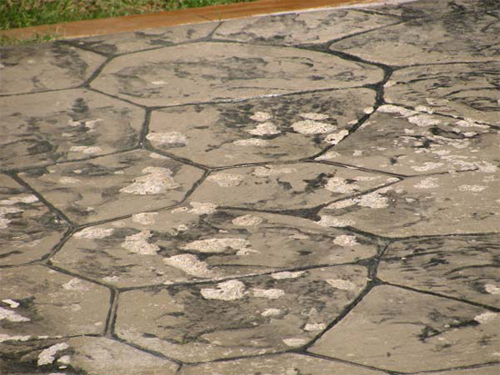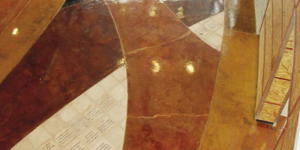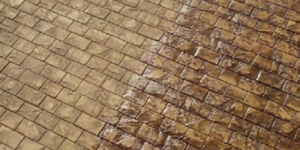When a problem occurs with a recently installed decorative concrete job, who is responsible? I understand that this is a loaded question, and there are lots of factors to consider, but the question still stands.
This spring, while dealing with a rash of stamped-concrete spalling issues, it came to my attention that the issue of responsibility after a job is not something most people even think about. After asking a bunch of questions and doing some research, it became evident that very few installers use contracts (for residential work) and for those who do, even fewer include any language dealing with potential first-year issues and how they will be dealt with if they do occur. While only a very small percentage of decorative work ends up not being acceptable, I have personally witnessed many small issues turn into expensive legal claims because there was no clear understanding between installer and client on what was acceptable first-year wear and tear and what was not.
To be fair, I will look at the issue from both sides (installer and homeowner), as well as discuss some simple ideas that will help resolve issues should they arise.
For the installer
A critical part of any decorative concrete service performed by a professional installer needs to be expectation management. Talk to any person not involved in the day-to-day business of concrete and you will find they view the product as an indestructible utilitarian material that will look, feel and perform as such for the next 100 years or more. The typical layperson does not realize that concrete is a product that is most often poured on-site, and being so is at the mercy of the environment, weather and job-site conditions, which change every day and definitely with every job. Add color, texture or any decorative element, and the level of expectation goes up exponentially. Unless you have a thorough explanation process regarding what to expect, the ideas and expectations floating around in your client’s head before you begin will be the benchmark by which the completed work will be judged.
After troubleshooting hundreds of concrete projects, I can tell you that extra time and cost upfront in terms of explanations, referrals, samples and plain old hand-holding will pay dividends after the job when questions start coming up regarding color, finish, cracks, joints, and the myriad of other issues that seem to surface after the job is complete. In fact, the right upfront expectation management and detailed product and process information eliminate most of those questions. This allows you the opportunity to be proactive with common concrete issues, such as color variations, cracking and overall artistic feel and appeal.
On the other hand, these proactive measures do not allow you to not deal with issues that occur, or worse yet, allow you to avoid or ignore a client’s questions or concerns.
As a special side note, I want to pick on one particular issue that always ends up in a bit of finger-pointing between the installer and homeowner in terms of responsibility, and is a personal pet peeve. The issue of concrete spalling and scaling is one that seemingly is getting worse year after year, and I don’t see anyone addressing the root of the problem. I know many of you will disagree with me, but my research (and about 1,000 years of history) have taught me that concrete is a pretty durable material and, if designed, mixed and installed properly, will last a very long time. To blame deicing salts and a bad winter for the surface coming off concrete after 10 months of service life is just plain wrong. If bad weather and salt caused concrete to spall within a year or two, then the world around most of us would literally be crumbling.
Rather, I think the industry has gotten lazy, and the basics of good concreting are being ignored. Concrete spalls because it has a weak surface caused by a high water-to-cement ratio at the surface combined with poor finishing technique, i.e., adding too much water to concrete in order to make finishing easier. Fast forward to the first winter, and we see how the expansion of water in the concrete by 9 percent when it freezes causes that weak layer to fail. Salt attracts water through the process of osmosis and makes a bad situation worse – but does not cause the problem.
So getting back on track, unless you specifically say that spalling is a possibility with all concrete you pour, it is your responsibility to repair or replace spalling concrete that has spent only a few months in service. You can’t expect a client to pay thousands or tens of thousands of dollars for a product or look that is arbitrary. Setting the proper standards and making sure you are both on the same page before you begin is your responsibility.
For the homeowner
If you’re a homeowner, you need to understand that there are five constants of concrete that will never change. These are, in no particular order:
- Concrete will get hard.
- Concrete will turn a color.
- Concrete will crack.
- Concrete will not catch fire.
- No one will steal your concrete.
Outside of those, everything and anything goes. You hire a professional to provide a finished product that at least meets your expectations and hopefully exceeds them.
Please understand that concrete is not an inanimate object. In fact, concrete contracts, expands, breathes and actually becomes one with the environment it is placed into. This big, heavy, colored, textured slab sitting behind, in front of or in your house or building is not immune to the everyday environmental beating the world we live in dishes out. In fact, it may need some occasional TLC, depending on the type of finish and level of customization you have requested. It is your responsibility to make your applicator aware of what you want in details that are as clear as possible. Demand samples, but don’t expect them for free.
Also, concrete is not like paint – you can’t just go over it if you don’t like the look or color. If something is truly wrong, you have the right to demand it be fixed or replaced to meet the agreed-upon level of expectation. However, you can’t demand or expect to have concrete replaced or repaired because the color is a bit darker, lighter or whatever than you expected. Understand that everything your installer does costs him or her money, and nothing is really for free. Do your homework, and live with the final product for which you paid $6 per square foot when all the other bids were $10 per square foot. Too often I get sent pictures of projects and asked, “Is this acceptable work?” Unless it is really bad, I usually ask, “What did you pay, and what did you agree to?” The last big item in dealing with responsibility is a contract. Contracts are important for both parties. Too often I hear after the pour, when an expectation issue has arisen, “I did not know contracts existed or that I even needed one.” I recommend them for every concrete project, small or large. They can be short and sweet, just as long as they call out in detail what is expected by both parties. There also needs to be language that clearly states who takes ownership of issues after the pour and when.
I also like warranties or guarantees within limits. These will only last for a few years, and will not cover issues such as random cracking or sealer issues caused by day-to-day environmental impact. While they are not short or simple, I like to use car warranties as a model when dealing with concrete contracts. Most new-car warranties cover the frame, power train and general guts of the vehicle. They don’t cover the paint job, windshield, light bulbs and interior aesthetics. The same should hold true for your concrete warranty. The structure, surface integrity and overall performance should be covered, while color, sealer performance, level of gloss, dog urine stains and tree sap are not. Having a good contract protects both parties and allows for a neutral third party to give an opinion if it happens to come to that.
My experience has taught me that if every concrete project were treated like a service – with managed expectations, detailed explanations on process and products, and written contracts – the number of unresolved problems would go down significantly. There are many qualified, professional concrete technicians out there performing really good work every day. These businesses take their responsibility to the industry seriously and understand that it is not just this job but future jobs that are at stake if you don’t perform. Responsibility for a project after the fact is something that needs to be considered before the job begins, unless, of course, you are that person who never has any problems with their decorative concrete projects.
















